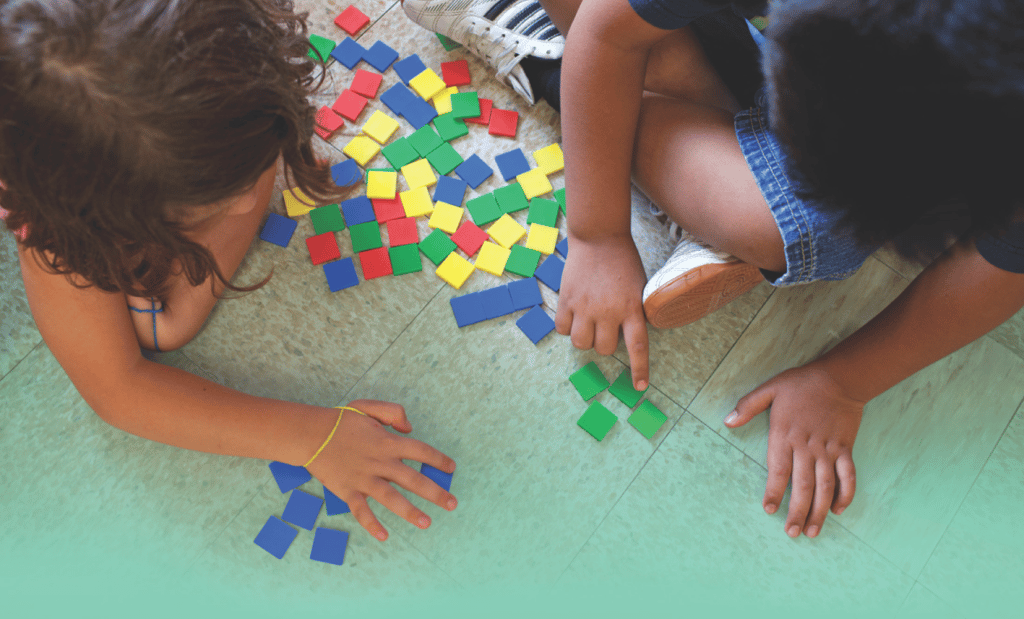
What is Cognitively Guided Instruction? Why do we do it?
Early on a Saturday morning a few weeks ago, I had a conversation with more than 200 teachers and administrators (and a few school board members) about Cognitively Guided Instruction (CGI). The conversation started when I posed the questions, “What is CGI and why do we do it?”
The response was inspiring, thought-provoking, and humbling.
-
Inspiring because the ideas shared highlighted the wisdom and commitment to young people.
-
Thought-provoking because the response pushed me to reconsider my own ideas of CGI.
-
Humbling because it reminded me about the power of collective work and how even in the most challenging times for education, together we can push back and work to change the status quo.
Before sharing what the group came up with, I want to explain why I began this conversation. Over the last year I have found myself needing to define or position CGI in particular ways. As I considered how I might do this, I recognized that CGI is not mine to define. CGI is not mine. It’s not even Tom Carpenter and Eliz Fennema’s. And it never has been.
CGI is not the same as it was over 30 years ago when it began. CGI continues to evolve because of the folks who are engaged in the work—and this includes teachers, administrators, students, and their families. It even includes those who may not attach the CGI label to their work but seek to hear and support young people’s mathematical voices and leverage them to support learning. Because of this, the definition of CGI can change from year to year. Its definition can’t be owned by any one person.
CGI is defined by our collective action. At times, it seems important to pause in that work and take note of where we are as a community, to make public our views so we can discuss, to challenge and move them forward. As we get ready for our biennial CGI conference in Seattle, it seemed like a good time to pause and consider: What is CGI and why do we do it?
I wish I could share all of the hundreds of teacher responses, handwritten on index cards. I am going to try here to do justice to the collective responses, choosing ones to share that are representative of the whole while still acknowledging the ideas of each person who participated in the conversation.
♦ ♦ ♦
You will not be surprised to hear that the responses to “What is CGI?” centered on students and their mathematical ideas.
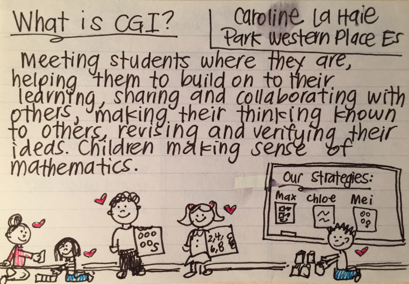
“CGI is understanding how children think mathematically in order to develop a sequence of problems and structures in math class that position students to see themselves as competent problem solvers and support them to engage in each other’s ideas so that they can build on their understanding of the underlying ideas of mathematics.” —Vanessa Hayward, Lawndale
“CGI is a student-centered approach to teaching math that builds on children’s intuitive ideas for solving math problems or tasks and in which the primary role of the teacher is that of a listener, facilitator, and strategic questioner. Students develop and grow their understandings through this strategic, purposeful listening, questioning and facilitation of their and their peers’ ideas. It is the happiest part of our day.” —Sumita Soni, Camino Nuevo Charter
“CGI is an approach to teaching mathematics that is guided by student thinking. Students are given opportunities to share with and learn from their peers. Teachers keep a record of students’ thinking to help guide future instruction. The teacher’s job is to listen and question based on what they see/hear.” —Adriana Mackavoy, Los Angeles
♦ ♦ ♦
Participants’ responses went beyond these ideas and overwhelmingly talked about empowering their students, building relationships, and competence.
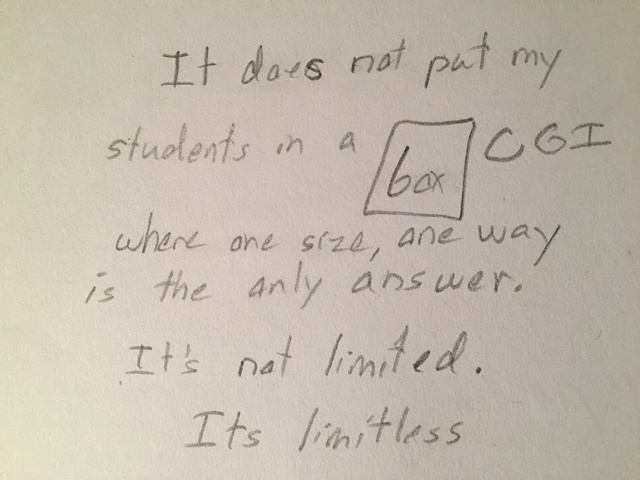
“CGI is intentionally giving students the opportunity and freedom to process and access math in the way that makes sense to them.” —Dana Elliott, Monrovia
“I do CGI because it inspires Delilah to stay in at recess because she is ‘good at math’ (her words) and she WANTS to solve this math problem!” —Robyn Stankiewicz, Pomona
“I do CGI in my classroom to empower my students so they will know themselves to be highly competent mathematicians. To honor them and their ideas (as opposed to congratulating them on correct answers or calling them out as incorrect).” —Kristian Knight, Culver City
“I do CGI as it gives each student a voice and it empowers students to take risks in their learning.” —Sylvia Chung, Fullerton
“CGI builds relationships—we learn about the kids in a personal way and push them to do things in ways they/we may not have imagined in the past.” —Aaron Brown, Norwalk-La Mirada
“I do CGI because it builds conversations and relationships between my students. I do CGI because my students feel challenged and excited to break apart new problems. I do CGI because there would be a revolt in my room if I didn’t.” —Suzanne Kelly, Tustin
“It puts students at the heart of what you do, and what is better than that?” —Chelsea Schneider, Lawndale
“Why? Because every kid deserves to see their value.” —Anonymous
♦ ♦ ♦
They discussed their own learning.
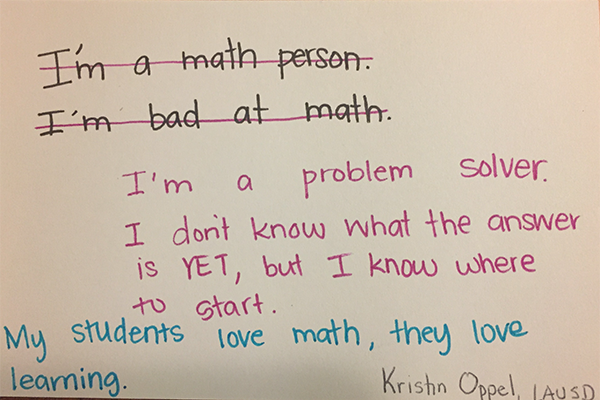
“I do it [also] for myself because I learn so much from and about my students that I discover more about myself as a student and as a teacher.” —Huong Dao, Fountain Valley
“Why do I do it? It challenges my assumptions about what students know and gives me the opportunity to get a better understanding of my math knowledge by growing as an educator.” —Luz Ponce, Long Beach
♦ ♦ ♦
They discussed curiosity, joy, and hope.
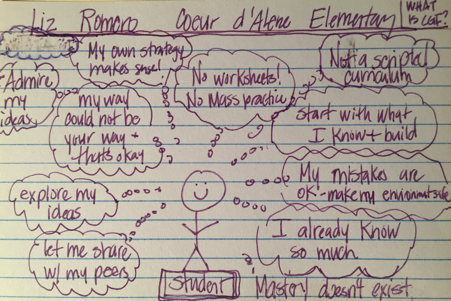
“My children love math—it’s the best part of our day! They BLOW me out of the room and challenge me!” —Susan Tate, Downey
“CGI is growing your mathematical mind developmentally; taking a journey with children along a winding path and enjoying the sites along the way, not running through to get to the end the quickest. CGI is fluid and unpredictable and filled with curiosity and joy.” —Carla Z. Madrid, Culver City
“There is great joy in creating a community that engages kids in challenges and celebrates them as doers of mathematics.” —Cristina Paul, UCLA Lab School
“A message of hope that math is for everyone, because everyone can make a contribution to how problems can be solved.” —Atoosa Abascal, Culver City
“[CGI] values students/people, their histories, and places. It focuses on the assets that students bring.” —Christine Kim, Lawndale
♦ ♦ ♦
I wonder how each of you would define what CGI is and why you do it. Please consider sharing your thoughts about and experiences with CGI in the comments section below. We want and need to continue our collective conversation and honor the variability, the commonalities, and the power of our learning together.
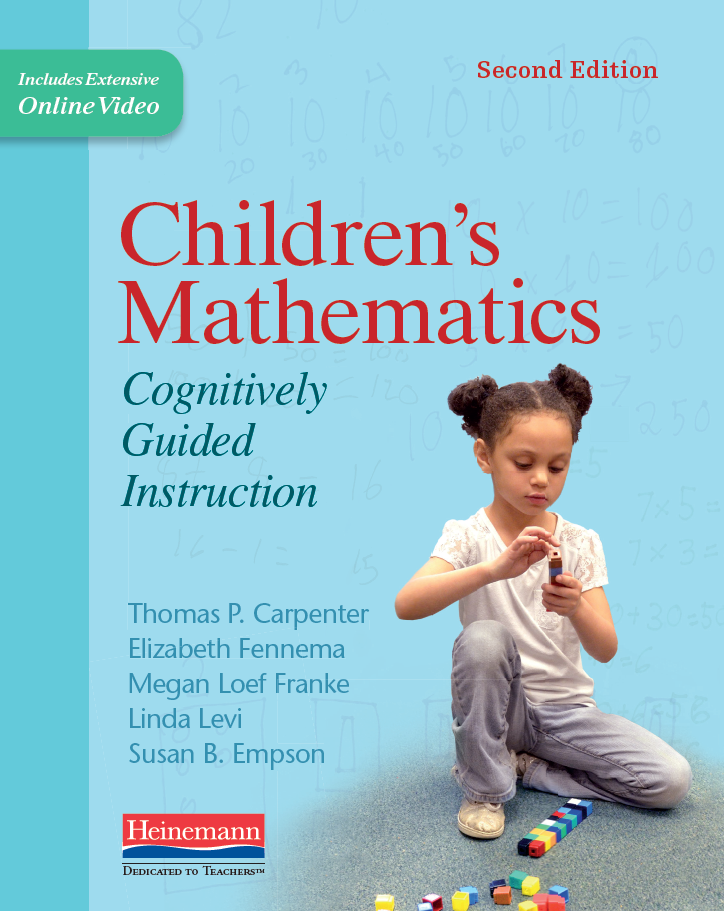 This post was written by Megan Franke with Cotsen Alumni CGI Conference Participants. Megan is Professor of Education at the University of California, Los Angeles. She is the coauthor of Children's Mathematics and Young Children's Mathematics. Follow her on Twitter @meganlfranke.
This post was written by Megan Franke with Cotsen Alumni CGI Conference Participants. Megan is Professor of Education at the University of California, Los Angeles. She is the coauthor of Children's Mathematics and Young Children's Mathematics. Follow her on Twitter @meganlfranke.


